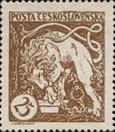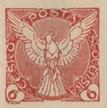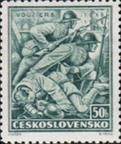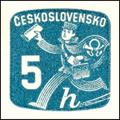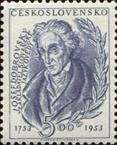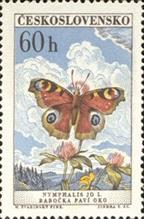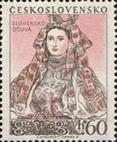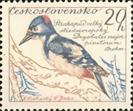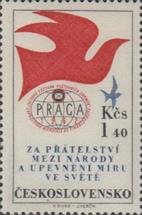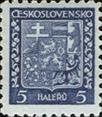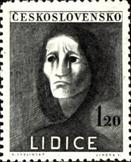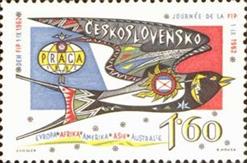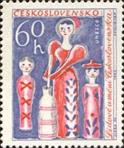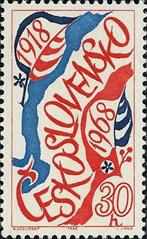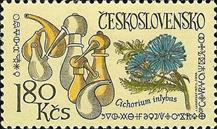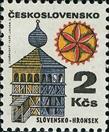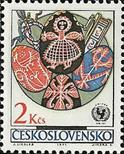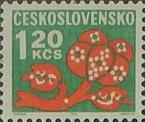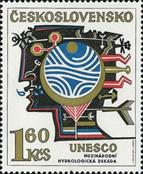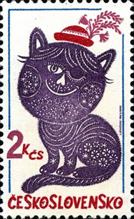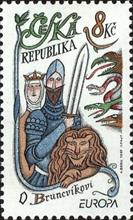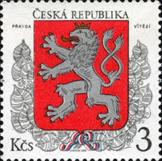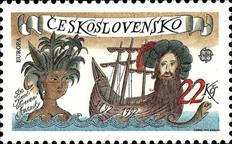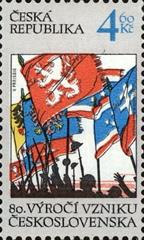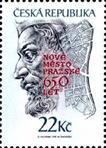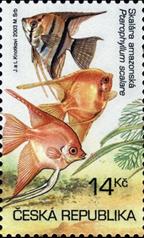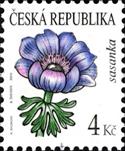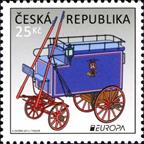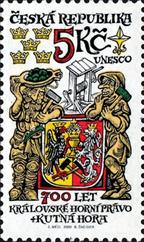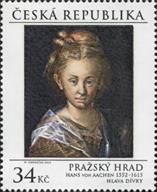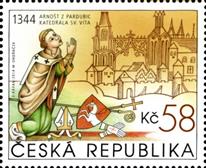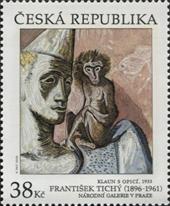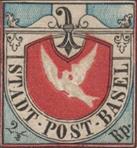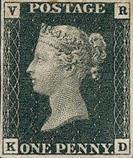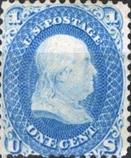P=have O=don’t have it
The
The Czech state or
In a 1948 coup d'état,
http://en.wikipedia.org/wiki/Czech_Republic
See
also: Slovakia stamps
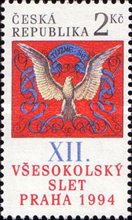
Scott: #2926P
Issued: 15.06.1994
12th Pan-Sokol Rally
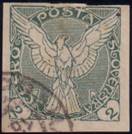 Inside #2940:
Inside #2940:
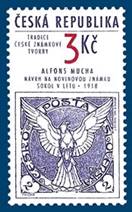
Scott: #2940PP
Issued: 20.1.1995
Czech Stamp Production
 Inside #2940:
Inside #2940:
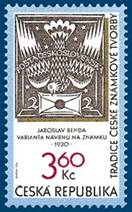
Scott: #2978PP
Issued: 20.1.1996
Czech Stamp Production
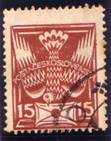 Inside #2978:
Inside #2978:
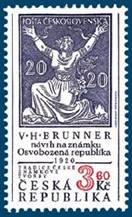
Scott: #3003P
Issued: 20.1.1997
Czech Stamp Production
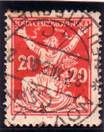 Inside
#3003:
Inside
#3003:
“The Liberated Republic" from 1920 by V. H. Brunner
![[Tradition of Czech Stamp Printing, type FJ]](Czech%20Republic_image018.jpg)
Scott: #3032P
Issued: 20.1.1998
Czech Stamp Production
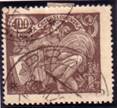 Inside
#3032:
Inside
#3032:
Science from 1920 by jakub Obrovský
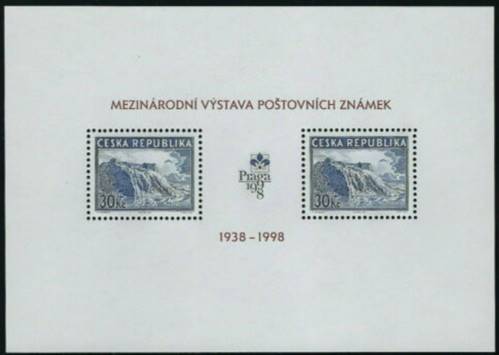
Scott: #3036O
Issued: 25.2.1998
History of Stamp Exhibitions/Praga
'98
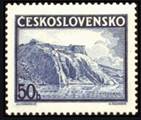 Inside #3036: Czechoslovakia #251aP
Inside #3036: Czechoslovakia #251aP
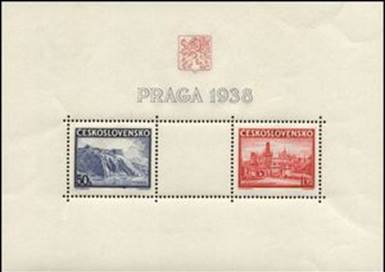
Czechoslovakia #251P
An engraver's
transcription of the PRAGA stamp on the theme of Vyšehrad from 1938, which
was engraved by K. Seizinger according to J.C.
Vondrouš's design.
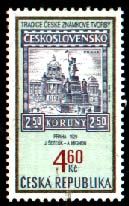
Scott: #3077P
Issued: 20.1.1999
The Tradition of Czech Stamp Production
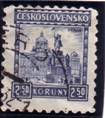 Inside
#3077:
Inside
#3077:
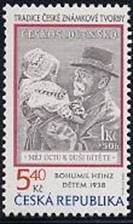
Scott: #3109P
Issued: 30.1.2000
Traditions in Czech Stamp Production
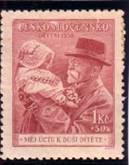 Inside
#3109:
Inside
#3109:
Bohumil Heinz´s
stamp for children from 1938. It shows President T.G.Masaryk holding a little
girl in national costume in his arms.
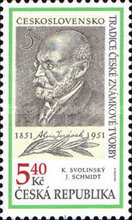
Scott: #3139P
Issued: 20.1.2001
Traditions of Czech Stamp Production
![[The 100th Anniversary of the Birth of A. Jirasek - Author, type ED]](Czech%20Republic_image036.jpg) Inside
#3139:
Inside
#3139:
Karel
Svolinsky s stamp originally issued in 1951 to mark Jirásek's 100th
anniversary of birth.
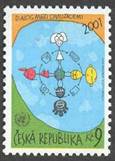
Scott: #3156O
Issued: 9.10.2001
Dialogue among Civilizations
Inside #3156: Pseudo Stamp on Envelope
Thanks to Lloyd Gilbert
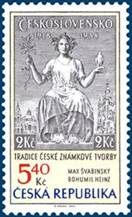
Scott: #3163P
Issued: 20.1.2002
Traditions of Czech Stamp Production
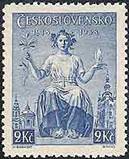 Inside
#3163:
Inside
#3163:
Max
Švabinsky’s stamp with the allegorical figure of the Republic, originally
issued in 1938 to mark the 20th anniversary of the
http://www.manresa-sj.org/stamps/2_CzechRep_2.htm
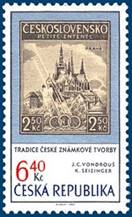
Scott: #3192aP
Issued: 20.1.2003
Traditions of Czech Stamp Production
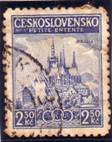 Inside
#3192a:
Inside
#3192a:
Jan
C. Vondrouš and engraver Karel Seizinger’s stamp of St. Vitus Cathedral of
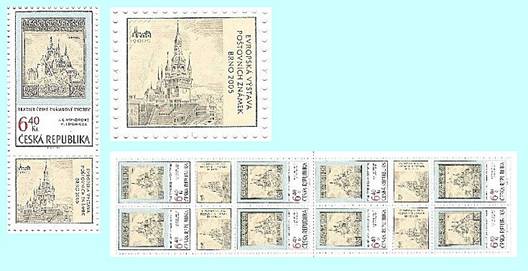
Stamp
booklet Brno 2005
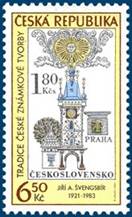
Scott: #3228
Issued: 20.1.2004P
Traditions of Czech Stamp Production
![[Ancient Buildings and House-signs from Prague, Brno and Bratislava, type BAZ]](Czech%20Republic_image051.jpg) Inside
#3228:
Inside
#3228:
A postage stamp with
the Green Frog sign designed by Jiří Švengsbír and
first issued in the 1970 issue House Signs and Gables.
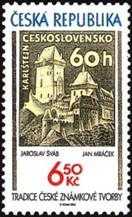
Scott: #3259P
Issued: 20.1.2005
Traditions of Czech Stamp Production
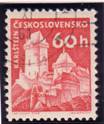 Inside
#3259:
Inside
#3259:
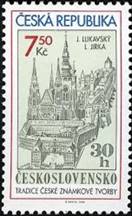
Scott: #3292P
Issued: 20.1.2006
Traditions of Czech Stamp Production
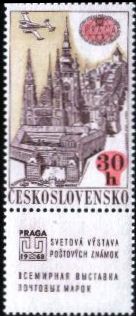 Inside
#3292: Czechoslovakia #C59P (Czechoslovakia)
Inside
#3292: Czechoslovakia #C59P (Czechoslovakia)
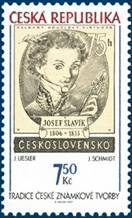
Scott: #3331PP
Issued: 20.1.2007
Traditions of Czech Stamp Production
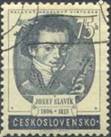 Inside #3331:
Inside #3331:
This year's postage stamp dedicated to the tradition of Czech stamp
design commemorates the painter and graphic designer Josef Liesler (1912-2005),
the author of more than a hundred of Czechoslovak and Czech postage stamps. The
first one was issued in 1947, the last one in 2002. J. Liesler graduated from
the
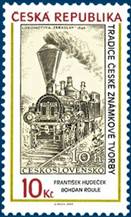
Scott: #3369P
Issued: 20.1.2008
Traditions of Czech Stamp Production
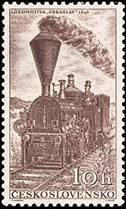 Inside #3369:
Inside #3369:
The annual "A Stamp on A Stamp" issue commemorates further
major designers of postage stamps - František Hudeček and the
engraver Bohdan Roule who together designed the 10h postage stamps featuring
the 1846 steam engine Zbraslav, issued in the 1956 series of postage stamps
Engines. F. Hudeček was the author of the entire issue of six stamps. The
painter, graphic designer and illustrator F. Hudeček (1909-1990) studied
with Prof. Kysela at the
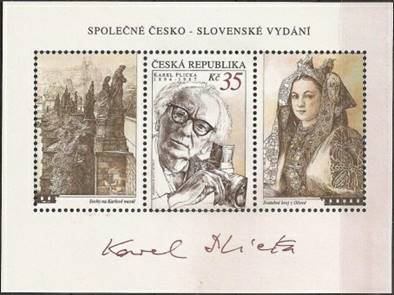
Scott: #3397O
Issued: 12.9.2008
KAREL PLICKA (1894-1987)
Issued jointly with Slovakia
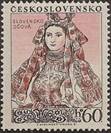 Inside #3397 (Right Label): Similar to
Czechoslovakia #707P
Inside #3397 (Right Label): Similar to
Czechoslovakia #707P
The theme of the common Czech and Slovak issue is the personality and
work of the artist of comprehensive gifts and activities K. Plicka (1894-1987).
Karel Plicka is a part of the culture of two - Czech and Slovak - nations. A
distinguished photographer and film maker, he was active also in music and
singing. His broad artistic activities in ethnography together with his sensitivity
of an artist and musician enabled him to record both in notation and on
photographs and film tapes the disappearing world of folk traditions, tales,
songs and way of life. He was also a significant teacher. He was first engaged
as a teacher at the
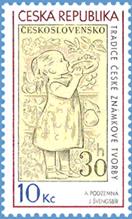
Scott: #3410P
Issued: 20.1.2009
Traditions of Czech Stamp Production
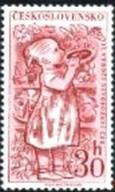 Inside #3410:
Inside #3410:
The tradition of Czech stamp design is commemorated this year by Anna
Podzemná's stamp of the issue The 15th Anniversary of the Czechoslovak
Liberation. This issue of five postage stamps which appeared in 1960 contained
two stamps by A. Podzemná created in cooperation with the engraver
Jiří Švengsbír. Podzemná's work is represented
by the 30 h stamp featuring a little girl eating a cake.
The painter Anna Podzemná-Suchardová (1909-1996) studied
at the school of arts and crafts UMPRUM and the
The drawer, graphic designer and engraver J. Švengsbír
(1921-1983) graduated from the school of arts and crafts UMPRUM in
The first-day cover of the issue features a pasqueflower from the 60 h
stamp commemorating the 20th anniversary of the
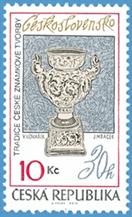
Scott: #3439O
Issued: 20.1.2010
Traditions of Czech Stamp Production
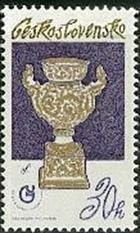 Inside #3439:
Inside #3439:

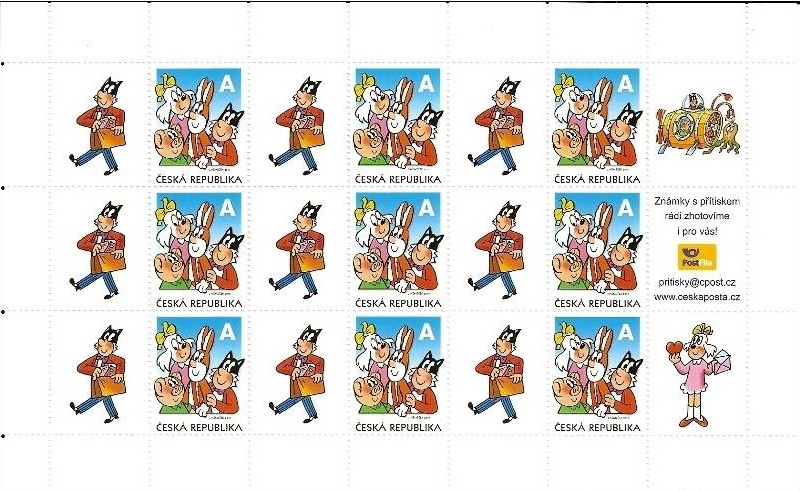
Scott: #????O
Issued: 01.09.2010
Czech comic book ![]()

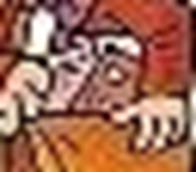
Inside #???? (On tab): Pseudo Stamp on Envelope
On 1 September 2010, the Czech Post issued its third
installment in the ongoing series featuring characters from the popular Czech
comic book ![]() .
.
This issue consists of a sheetlet with 9 stamps with
peronalizable labels.
The stamps show all 4 main
characters, including the cats scientist My![]() pulin,
whi is also featured on the prototype labels, as well as on the upper Right
label of the sheetlet.
pulin,
whi is also featured on the prototype labels, as well as on the upper Right
label of the sheetlet.
The stamps are
denominated 'A', which is the inland postage for letters up to 50g (CZK 10.00
at time of issue).
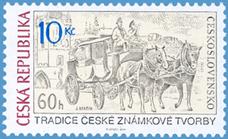
Scott: #3484P
Issued: 20.1.2011
Traditions of Czech Stamp Production
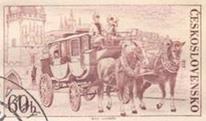
(Thanks to Lou for the scan)
Lou wrote: I just bought the very elusive 1966 imprinted envelope
from Czechoslovakia with the indicium adapted for the 2011 Traditions issue. It
is a flown first day cover, so I'm sending a scan of the cropped indicium with
a partial cancel. This cover had interesting travels in its
history: from Czechoslovakia to the U.S., then somehow to a dealer in
Pakistan, and now back to me in the U.S.!
Inside #3484: 60h “Mail coach on Charles Bridge” stamp from
imprinted envelope
issued
for Union of Czechoslovak Philatelists Exhibition,
The 2011 issue in the series Tradition of Czech Stamp Design is a
single-colour stamp, printed by the rotary recess method, which first appeared
on the "Mail Coach on
Josef Herčík (March 22nd, 1922, Uherský Brod - July
9th, 1999, Prague) was one of the leading Czech engravers in the post-World War
II era, mainly due to the large number of national and international awards he
received for his contribution to the art of engraving in stamp design. As the
author of more than 400 stamp engravings, Josef Herčík managed to
overcome even Jindra Schmidt and became the most prolific Czechoslovak
engraver.
Josef Herčík's started his art career in the almost
forgotten craft of gunstock engraving in the arm producing firm Zbrojovka
Uherský Brod. He moved to
Although mainly recognized as a stamp engraver, he also authored a
large spectrum of other graphic works, such as drawings, book covers and
illustrations, bibliophilic works. His engravings for the 1958 edition of
Arthur Rimbaud's "Le bateau ivre", designed by painter František
Tichý, was the first work that made him publicly visible. His
cooperation with graphic designer Václav Sivko, which started at the
same time, introduced him to stamp engraving; Herčík's first stamp
engravings followed Sivka's designs used for the PRAGA 1962 exhibition,
although his first "real" stamp engravings featuring two insect
motifs appeared later.
Herčík worked mainly for the Czechoslovak stamp design, but
several of his works became also internationally renowned. He engraved an
extensive series of facsimiles of famous stamps, e.g. the Blue Mauritius, for
the German philatelic firm Hermann Sieger, as well as a few stamps for other
postal administrations, such as
Herčík covered also other areas of graphic design, such as
free or heraldic graphics. As a heraldic designer he was even commissioned to
design and engrave almost all Czechoslovak issues including heraldry of Czech
or Slovak towns.
Josef Herčík and his wife Helena remained very active and
enterprising in the graphic arts industry even in old age. The printing firm
"1. česká grafická
společnost", set up by them and their son Josef Herčík
Jr.'s family in the 1990s, soon attracted major printing and graphic contracts
from around the world.
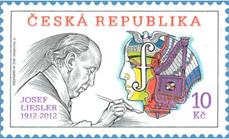
Scott: #3523P
Issued: 20.1.2012
Traditions of Czech Stamp Production
 Inside
#3523: TBI
Inside
#3523: TBI
The newly outlined Tradition of Czech Stamp Design issue
commemorates another of Czechoslovak and Czech stamp designers - Josef Liesler
(19 September 1912, Vidolice u Kadaně - 23 August 2005,
Liesler
was a Czech painter, graphic artist and illustrator. In the 1930s he graduated
from the
He taught drawing courses in 1945-49 and all his life remained proud of
his work as a teacher. He considered drawing as the basis of art. In his own
work he preferred graphic art, especially lithography, which gave him a chance
to apply harmony between precise lines and colours.
In October 1939 he entered the history of Czech art by organising,
jointly with some other artists, an independent exhibition at the Topič
Salon. The artists called themselves Sedm v říjnu(Seven
in October). The event was triggered by sculptor Vincent Makovský who
met the young artists in the U Štýdlů pub and offered them the
time window for his
At that time Liesler followed expressionism. His paintings reflected
the occupation time described in symbols. In his soul he always was a humanist,
and kept fighting also in his art against any form of restriction of freedom.
His paintings brim with rich shapes and full colours.
He was admitted as a member of the prestigious association of artists
Mánes during the war, when he was still a young man. He was also one of the
oldest surviving members of Hollar, the association of artists he was proud to
belong to. Liesler won a number of awards, such as the UNESCO World´s Most
Beautiful Stamp Award (1975). Despite the initial lack of trust on the side of
philatelists - Liesler was too much modern and unconventional an artist for
them - he designed more than a hundred of stamps. He was very proud of his
membership in the glorious Academy in
![[The 150th Anniversary of the Foundation of the Sokol (Falcon) Movement, type ZZ]](Czech%20Republic_image098.jpg)
Scott: #3525P
Issued: 15.02.2012
The 150th Anniversary of the Foundation of the Sokol (Falcon) Movement
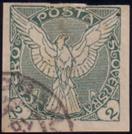 Inside #2940:
Inside #2940:
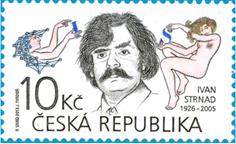
Scott: #3560P
Issued: 20.1.2013
Traditions of Czech Stamp Production
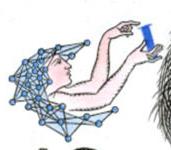

Inside #3560: 1975 postal stationery (50th anniversary of
the launch of automated telephone operation in
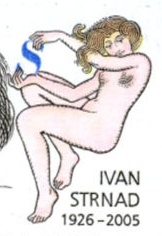
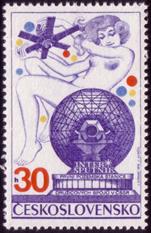 Inside #3560: Czechoslovakia #1936P
Inside #3560: Czechoslovakia #1936P
The newly outlined Tradition of Czech Stamp Design issue
commemorates another significant stamp designer, Ivan Strnad. The stamp shows a
portrait of Ivan Strnad; a part of the mirrored motif which first appeared on a
1975 postal stationery item commemorating the 50th anniversary of the launch of
automated telephone operation in Czechoslovakia, placed in the left-hand side;
and a female nude from the 30h stamp Intersputnik issued in 1974, placed in the
right-hand side.
Czech graphic artist and teacher Ivan Strnad was born on 3 April
Ivan Strnad taught students in a special applied graphic arts studio at
the
During his lifetime he won many awards for his works of art. Most of
them came for his stamp designs (1964: 2nd prize for the stamps 20 Years of the
The coupon features a head drawing fron the background of the 1
Kčs stamp which appeared in the 1977 Space Exploration series.
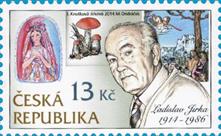
Scott: #3594O
Issued: 20.1.2014
Traditions of Czech Stamp Production
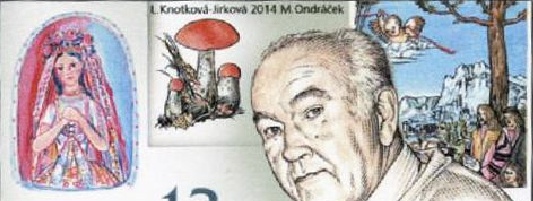
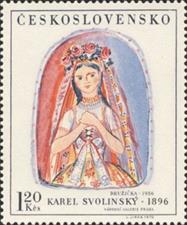 Inside #3594: Czechoslovakia #1712P
Inside #3594: Czechoslovakia #1712P
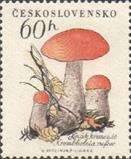 Inside #3594:
Inside #3594:
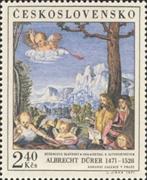 Inside #3594: Czechoslovakia #1783P
Inside #3594: Czechoslovakia #1783P
A portrait of Ladislav Jirka,
accompanied in the background with three of his stamps he valued most of his
work: Bridesmaid - Art 1970 (K. Svolinský), Leccinum versipelle, 1958 (K. Svolinský), and a detail from The Feast of the
Rosary - Art 1971 (A. Dürer).
Ladislav Jirka (1914-1986) was born in Třemošná
u Plzně. In 1928, he started to study the art of
engraving with František Malinský
in Plzeň. In 1936, he joined the engraving
department of the Military Geographical Institute. In 1939, he passed the
admission examination and joined the state-owned stamp and banknote printing
house Státní tiskárna
cenin as a banknote engraver. By his 1948 portrait of
Ľudovít Štúr,
designed by Karel Svolinský, he also joined
the ranks of stamp engravers. His meeting with Karel Svolinský
developed into a long-term cooperation. Jirka
engraved many of Svolinský’s stamps with folk
and mainly nature motifs. He also used designs by other major artists; the best
remembered was his cooperation with Mirko Hanák, Cyril Bouda and
Josef Liesler. At the same time, he used classical
works of art as a basis for engravings.
He received several awards for stamp design and works of art.
Thanks to Lou Guadagno
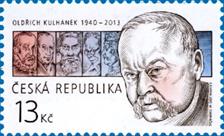
Scott: #3624O
Issued: 20.1.2015
Traditions of Czech Stamp Production
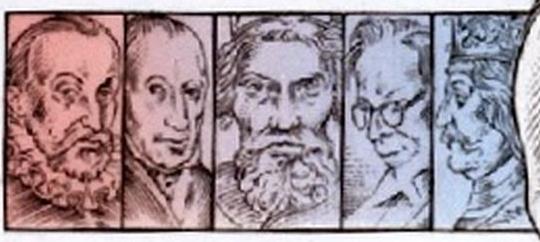
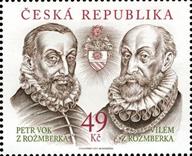 Inside #3624: Czech Rep. #3494O
Inside #3624: Czech Rep. #3494O
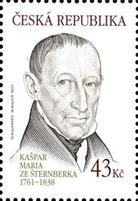 Inside #3624: Czech Rep. #3483O
Inside #3624: Czech Rep. #3483O
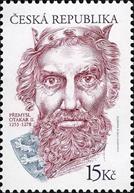 Inside #3624: Czech Rep. #3314CO
Inside #3624: Czech Rep. #3314CO
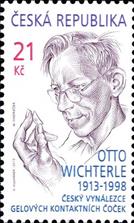 Inside #3624: Czech Rep. #3590O
Inside #3624: Czech Rep. #3590O
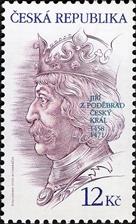 Inside #3624: Czech Rep. #3374O
Inside #3624: Czech Rep. #3374O
The newly outlined Tradition of Czech Stamp Design issue
commemorates another significant stamp designer, Oldřich
Kulhánek. The stamp shows a portrait of Oldřich Kulhánek
based on the same imaging principle as the one used by Kulhánek.
This means that attention is paid also to details that do not compliment but
emphasize the image of a “tired philosopher”.
Oldřich Kulhánek is a world famous artist. He was born on
26 February 1940 and died on 28 January 2013. He started to study
arts at the Art School in Prague and continued his studies at the Academy of
Arts, Architecture and Design in Prague in the class of Professor Karel Svolinský. The years spent with this teacher laid
down the basic foundation for Kulhánek’s
career as an artist.
Kulhánek mostly
concentrated on graphic art and drawings. He also designed the new Czech
banknotes and many Czech postage stamps.
In 1971, he was arrested by Czech secret police and charged with
disparaging representatives of Communist countries (a reference to the
portrayal of Stalin in some of Kulhánek’s
graphic sheets).
This led to a total ban on exhibiting his works, co-operating with any
publishers or using any publicity in the 1970s. In spite of the ban, he used
numerous friends in the United States, Netherlands, Belgium, Germany, Austria
and France to stay in touch with Europe’s art scene. The situation changed
after the 1989 fall of the Communist regime in the then Czechoslovakia. During
his first visit to the United States in 1990, Kulhánek
attended the Litographic Workshop in Los Angeles. A
number of visits to the United States followed. He led the drawing workshop in
the Atlantic Center for the Arts, New Smyrne Beach in
the summer of 1991. In 1995, he stayed at the University of Houston, Clear
Lake, Texas. He chaired the Stamp Design Board of Česká
pošta, s.p.
Thanks to Lou Guadagno and Prof. Plinio Richelmi
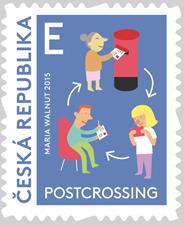
Scott: #3648P
Issued: 02.09.2015
Postcrossing


Inside #3648: Stamps on envelopes
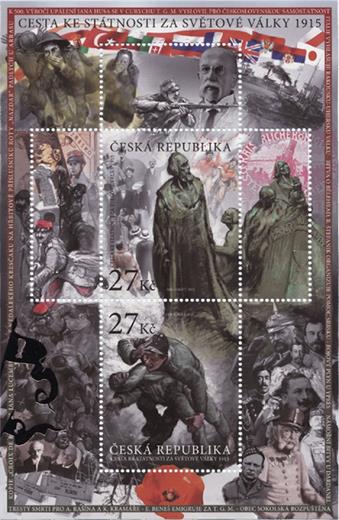
Scott: #3654P
Issued: 14.10.2015
Czech Statehood
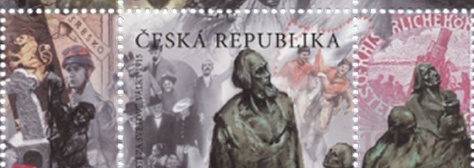
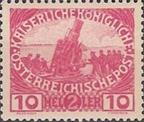 Inside #3654 (In Label): Austria #B5O
Inside #3654 (In Label): Austria #B5O
The first stamp depicts the ceremony of unveiling of the monument to
Master Jan Hus marking the five-hundredth anniversary of his burning. Although
the long-planned celebrations were banned, the unveiling of the monument to
Master Jan Hus on the day of the 500th anniversary of his burning became a
clear demonstration of the specific national aspirations.
A group of Czech exiles fleeing the country after the Battle of White
Mountain, symbolising the despair over the loss of
their homeland, was added to the figures of Jan Hus and God’s warriors.
At that time, the development of the Czech lands, which were then at
Europe’s cultural peak, was actually strangled. It used to be the only country
boasting tolerance between Catholics and Protestants. Czech was the official
language; the authors of the Bible of Kralice,
translators from the Unity of the Brethren, elevated it to a language able to
express every emotional and legal aspect of human existence. The coupon shows
the slogan “The truth will set us free” written on the shield with a chalice
used in the monument, which was very significant and binding for the design of
the monument created by Šaloun. The yearning for
living in truth eventually made its way to the presidential flag.
The banner of the battalion company “Nazdar”
in the left-hand coupon in the miniature sheet marks the formation of the
Czechoslovak Legions in France and their combat deployment in the area around
Arras. Under the banner is a replica cross of John of Luxembourg from Crecy.
Czechs and representatives of the Czech state militarily engaged in the area in
northwestern France since the Middle Ages. The village
of La Targette near Arras is the place of a cemetery
of Czechoslovak members of the battalion company “Nazdar”,
killed there during the Battle of Arras on 9 May 1915. In 1924, on the
initiative of the Association of Czechoslovak Volunteers in France, a place for
construction of a monument to Czechoslovak soldiers fallen in France was
purchased there and the remains of soldiers from all the battlefields of the
Western Front fallen in the years 1915-1918 were gradually collected there.
After 1945, the remains of Czechoslovak soldiers fallen in 1940 and at the end
of the Second World War during the Battle of Dunkirk, including 29 Czech
pilots, were brought there. The stone cross erected in the middle of the
cemetery is a replica of the “Czech Cross” (Croix de Bohême),
the original of which stands in the nearby fields of Crecy-en-Ponthieu and commemorates the death of the blind Czech King
John of Luxembourg in the Battle of Crecy on 26 August 1346.
The tombstones have a uniform design (a cross for Christians, a round
stone for other denominations) and state the name of the fallen soldier, the
rank, unit and date of death, if known, with a single phrase “Mort Pour la Patrie” (Died for the Country).
The left-hand coupon portrays M.R. Štefánik
in a flying helmet. Štefánik was not
surprised by the beginning of war; he saw the war mainly as a chance of
obtaining independence for Slovaks, which he associated from the beginning with
Czech independence. In the early 1915, he received a pilot diploma and the rank
of corporal. During his work as an aviator, he always had in mind the
independence of Czechs and Slovaks and tried to set up Czech-Slovak volunteer
units. In the early September 1915, he was sent to the Serbian front where he
further developed his attempts. After the defeat of Serbia, Štefánik
returned to Paris where he became acquainted with the most important
politicians, such as Prime Minister Aristide Briand and the most influential
man at the French Foreign Ministry, Philippe Berthelot. Štefánik
continued to push through the plan of a creation of a Czecho-Slovak
state. At a meeting with E. Beneš on
13 December 1915, they agreed on Štefánik’s
and Masaryk’s concept of an independent state. Štefánik’s
new role, set by himself, was to set up a single control centre for joint
resistance of Czechs and Slovaks, create independent Czecho-Slovak
troops, and make them known among politicians.
He informed Prime Minister Aristide Briand about these plans and
arranged for his meeting with Masaryk. The meeting of Briand and Masaryk was
successful and Masaryk convinced Briand to accept the concept of a solution to
the Central European issue.
The lower left-hand part of the miniature sheet contains a tangle of
still alive and already dead, furiously attacking and helplessly falling Czech
soldiers in the uniforms of opposing armies, with crosses symbolising
suffering and hope in the background. It also contains fictitious police
portraits of Czech politicians K. Kramář
and A. Rašín, future Czech Prime
Minister and Minister of Finance respectively, sentenced to death. The war
hysteria of the monarchy led to the intensification of sanctions against
national manifestations. T.G. Masaryk and E. Beneš
emigrated to avoid persecution. Czech associations were dissolved and the use
of the Czech language in official communications was prohibited. Books on Czech
history and Czech magazines were prohibited, censorship mopped up books and
repertory of theatres, school libraries were closed.
The lower part of the miniature sheet depicts a war “Pieta”.
The upper left-hand part commemorates one of the most insidious weapons
- the use of poison gas at Ypres. The idea of using poison gases was conceived
by the Germans. The gas was transported to the front lines in metal bottles. On
a given day, if the wind was right, the valve of a bottle was turned on and the
gas started to escape. The deadly cloud was driven by the wind across the no
man’s land to the enemy lines. On 22 April 1915, after two days of
artillery shelling that destroyed the medieval town of Ypres, British soldiers
noticed a yellow-green cloud rising over the German trenches. The cloud hit the
left wing of the British trenches. The deadly cloud of chlorine hit the French
troops, mostly originating from Algeria. They were helpless and ran away from
the battlefield. The Canadian troops, also hit by the edge of the cloud, kept
up. They used primitive means to defend themselves, such as socks soaked in
urine. On 24 May 1915, after another month of uninterrupted fights, the
Germans once again ordered a gas attack on Ypres. The gas cloud hit the
Canadian troops. They managed to keep up at the cost of horrible losses.
The upper right-hand part contains a view of the sea conflict. Although
the naval operations against Turkey in the Dardanelles were not the main focus
of Czechs, W. Churchill, one of the main authors of the concept of landing
in Gallipoli was crucial for the further fate of the world and cannot be
overlooked. The landing failed and led to the defeat and departure of the
Serbian army. The Dardanelles campaign decided the fate of Serbia. Until the
British invasion during the Battle of Gallipoli continued, Bulgaria did not
dare to attack Serbia, but instead waited for the help from Greece and Romania.
When it became clear that the British attack on Gallipoli was losing steam, the
situation in the Balkan battlefield suddenly changed. On 6 October 1915,
Serbia was attacked. The Bulgarian attack came through the valley of the Morava
river while the Austro-Hungarian army attacked
Belgrade. The Battle of Belgrade was incredibly cruel, and the Serbs had no
chance against the overwhelming odds even with the help of the British and
French artillery. The remnants of the army retreated in appalling conditions
through Albania and Montenegro to the Adriatic coast. Serbian historiographs of this period often call it the Serbian
Golgotha.
The lower right-hand part depicts some actors of the global conflict:
Russian Tsar Nicholas II, General Hindenburg, later German president,
English King George V, Kaiser Wilhelm II of Prussia, Marshal
Ferdinand Foch, Japanese Emperor Taisho Yoshihito, Emperor Franz Joseph I
and the already mentioned Winston Churchill, the then First Lord of the
Admiralty and Secretary to the Navy.
The right-hand part of the upper coupon portrays Tomáš
Garrigue Masaryk. During the First World War, Masaryk
abandoned his original opinion that Austria-Hungary could be reformed into a
modern union of autonomous countries. In January 1915, he went to Switzerland.
He submitted an “Independent Bohemia” memorandum to the British Foreign
Minister, which suggested “restoration of the Czech Republic as an independent
state”. He also proposed a personal union of Serbia and Czechoslovakia. At a
meeting in the Reformation Hall of the University of Geneva on 6 July
1915, he made his famous speech marking the 500th anniversary of the
burning of Jan Hus, in which he declared a war to the Hapsburg domination: “We
condemn violence, and we do not want to use it. But if necessary, we will use
iron against violence.” In the nearby Chamonix Mont Blanc in France, Masaryk
met Štefánik. Masaryk admired the organisation and secrecy of the Sicilian Mafia; the Czech
resistance organisation, as a secret society, was
therefore named the Czech Mafia. During the First World War, members of the
Czech Mafia became the driving force behind Czech resistance, influenced by
Professor Masaryk from his exile.
In the axis of the sheet at the very bottom is a red poppy flower. “In
Flanders fields the poppies blow. Between the crosses, row on row.” These words
from a poem by Canadian Lieutenant John McCrae, written in 1915 in honour of a fallen friend, spread very quickly and
contributed to the fact that poppies began to be associated with the victims of
war conflicts. For centuries poppies grow on all battlefields, apparently due
to the presence of lime penetrating into the soil from the rubble.
The flags of the participating countries flutter above it all. The red
and white bicolour already quietly emerges in this
miniature sheet.
Thanks to Lou Guadagno and Attilio Papio
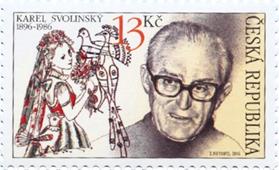
Scott: #????O
Issued: 20.1.2016
Traditions of Czech Stamp Production
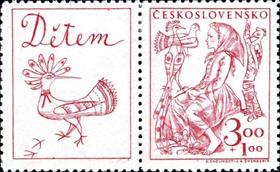 Inside #????:
Czechoslovakia #B165P +
label
Inside #????:
Czechoslovakia #B165P +
label
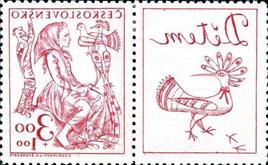

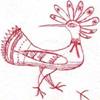
Design components: stylized birds only, reversed images
a portrait of Karel Svolinský based on
a photograph (made by Tomáš Vosolsobě about 1977) provided by the Postal Museum;
the stamp also includes a collage of fragments from book illustrations (Czech
Year, Plants, about 1948) and a postage stamp (Moravia - Těšínsko
Region, 1947).
Karel Svolinský (14 January 1896,
Svatý Kopeček u
Olomouce – 16 September 1986, Prague) was a
leading Czech painter, graphic artist, illustrator, typographer and letter
designer, stage designer, and university teacher.
From 1910-1916, he trained as a carver in Prague. From 1919, he
continued his studies at the Academy of Arts, Architecture and Design in
Prague. He studied painting and graphic design with Štěpán
Zálešák (1919-1921) and sculpting
with Bohumil Kafka (1921). After suffering an injury,
he focused mainly on graphic design and murals, which he studied with František Kysela from
1922-1927. From 1945, he worked as the head of the Special Department of
Applied Graphic Art at the Academy.
The focus of his work was on drawing inspired by folk traditions,
costumes, and nature. Other areas of his work included graphic art and design
(book plates, posters, banknotes, stamps) using experimental graphic
techniques. Due to his training as a carver, his typical graphic techniques
were wood engraving and wood carving. He was also an outstanding book designer
and illustrator. He designed tapestries and was a successful stage designer. He
is best known as the designer of several monumental works: the stained-glass
window of the Schwarzenberg chapel in St. Vitus Cathedral in Prague
(1930-1931), and a new design of the Astronomical Clock in Olomouc in the style
of socialist realism (sculptor Olbram Zoubek contributed to the creation of the figures in
collaboration with Svolinský’s wife Marie).
Svolinský worked
as a stage designer from 1940 when he was invited by conductor Václav Talich to create
the set for Dvořák’s opera The Jacobin in
the National Theatre. He was invited as a guest stage designer mainly for Czech
opera sets in Prague, the State Theatre in Brno, Olomouc, Plzeň
and other cities. He was also invited to design the set for Janáček’s
Jenůfa in the Vienna State Opera in 1968.
Svolinský
illustrated many books, such as Karel Plicka and
Frantisek Volf’s Czech Year published in four volumes
in 1944-1960, and covers for musical scores by e.g. Bedřich
Smetana, Leoš Janáček,
Zdeněk Fibich. His commemorative edition of Mácha’s
romantic poem Máj, with Svolinský’s
original lettering and many illustrations, was displayed at the International
Decorative Art Exhibition in Paris, 1925. After its success, he published his
font Wenceslas with the English company Monotype in 1933. He also designed
posters, postage stamps, book plates, banknotes and created numerous
stained-glass windows, mosaics and glass paintings. From 1935, Svolinský was a member of the association of artists
“Mánes” and an honorary member of the
association of Czech graphic artists “Hollar”. He
carried on the legacy of the tradition of Mánes
and Aleš in Czech visual arts.
The postage stamp is issued both in the form of sheets and as a book of
8 stamps and 4 coupons.
Thanks to Lou Guadagno
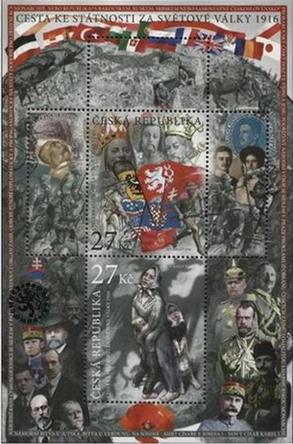
Scott: #3689O
Issued: 23.10.2016
Fight for Czech Statehood

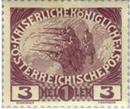 Inside #3689 (In Label): Austria #B3P
Inside #3689 (In Label): Austria #B3P
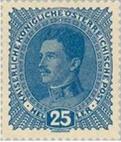 Inside #3689 (In Label): Austria #170P
Inside #3689 (In Label): Austria #170P
Thanks to Lou Guadagno
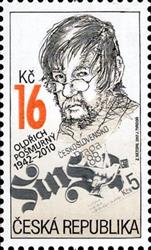
Scott: #3694O
Issued: 20.01.2017
Traditions in Czech Stamp Production
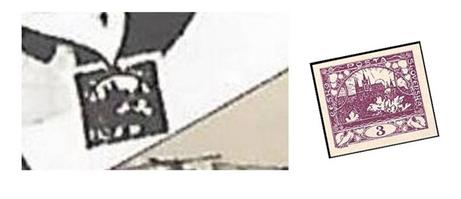
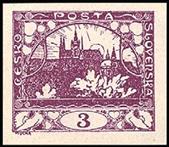 Inside #3694: Czechoslovakia #1P
Inside #3694: Czechoslovakia #1P
Czechoslovakia essay for unissued Praga 88 stamp
A stamp on stamp which reproduces Czechoslovakia
#1, making the new issue a stamp on stamp on stamp
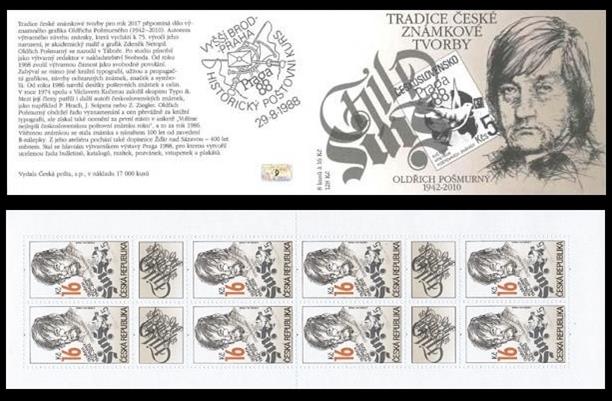
Booklet pane
Thanks to Lou Guadagno
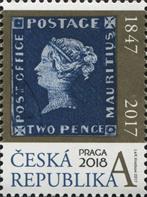
Scott: #3717P
Issued: 06.09.2017
Praga
2018 Publicity: Mauritius and Czech Philately
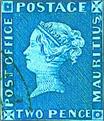 Inside #3717: Mauritius #2O
Inside #3717: Mauritius #2O
The Mauritius rarity is owned by a Czech
collector, and will be on display at the 2018 exhibition with other Mauritius
material he possesses.
Thanks to Lou Guadagno
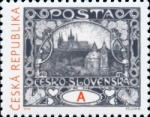
Scott: #????O
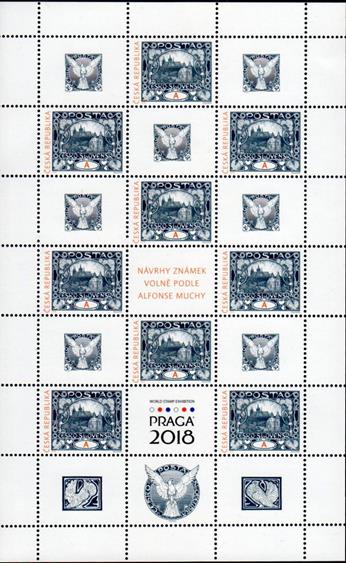
Scott: #????P
Issued: 21.02.2018
Alphonse Mucha/ Praga 2018 Publicity
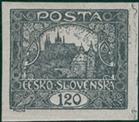 Inside #????:
Inside #????:
1919 (Pic of #36) - modified: new value, changed color
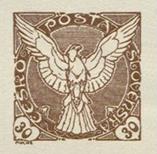 Inside #???? (In 7
labels): Czechoslovakia #P6O
Inside #???? (In 7
labels): Czechoslovakia #P6O
newspaper
stamp (1918) - modified: changed color
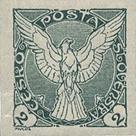 Inside #???? (In bottom
label): Czechoslovakia #P1P
newspaper stamp (1918)
Inside #???? (In bottom
label): Czechoslovakia #P1P
newspaper stamp (1918)
design
component: Windrover bird design motif only, without
frames and values in changed color,
In two bottom end labels: left and right Pigeon bottom
frame elements from all 1918-19 Hradcany Cathedral
issues.
All are Mucha works.
Lou wrote: For some reason, the designer of this issue,
which honors Alphonse Mucha, the Czech artist who created
many of the first stamps of Czechoslovakia and also publicizes the Praga 2008 Exhibition for the centenary of the stamps of
1918, has chosen not to illustrate that first stamp. Instead he has used
the 1919 Type IV modified design of the last issue of Hradcany
stamps. This is the second time a design of 1919 was ued
to commemorate the stamp anniversary; in 1958, for the 40th Anniversary of
Czech stamps (Sc #896), the female allegory of Czechoslovakia is shown
presenting laurel leaves to a replica of a stamp on the wall. Instead of the
reproduced stamp showing the words "Cesko-Posta-Slovenska" in the left, top and right frames of the
1918 first issue, 'Posta-Cesko-Slovenska" is in the top and bottom frames with
ornament frames to the sides, again, as the Type IV issues of 1919. For the
1968 50th Anniversary issue (Sc #1600), the correct stamps, Czechoslovakia #1-2 are shown in changed color.
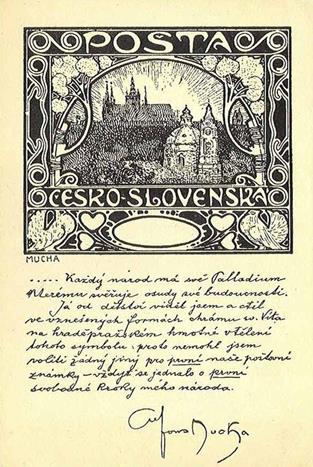
I think I found the designer's source for this
issue. Several years ago, while surfing for Mucha
essays, I came across an undated print of an essay described and signed by Mucha, which is the Type IV base of the 2018 design. The
source info is gone, and I could not find it again on a recent search, but I
think it is worth showing.
Also, the artist's name is written as "Muchy" in the center label, a rarely seen, but perhaps
a more "Czech" spelling of his name, altho
all his signed works have "Mucha".
Thanks
to Lou Guadagno and Komlóssy Zoltán
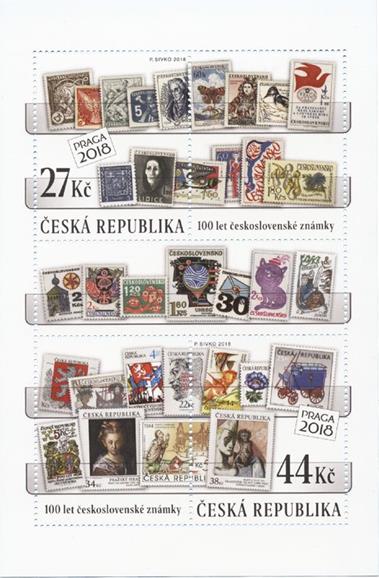
Scott: #????O
Issued: 20.06.2018
100 Years of Czech Stamps

|
|
|
|
|
|
|
Czechoslovakia #B125P |
Czechoslovakia #P3O |
Czechoslovakia #244P |
Czechoslovakia #P27P |
Czechoslovakia #575O |
|
|
|
|
|
|
|
Czechoslovakia #1086O |
Czechoslovakia #707P |
Czechoslovakia #942P |
Czechoslovakia #C54P |
|

|
|
|
|
|
Czechoslovakia #152P |
Czechoslovakia #329P |
Czechoslovakia #1133O |
|
|
|
|
|
Czechoslovakia #1196P |
Czechoslovakia #1515O |
Czechoslovakia #1776P |

|
|
|
|
|
|
Czechoslovakia #1735P |
Czechoslovakia #1789P |
Czechoslovakia #J101P |
Czechoslovakia #1934O |
|
|
|
|
|
|
Czechoslovakia #1969P |
Czechoslovakia #2325P |
Czech Rep. #3013P |
|

|
|
|
|
|
|
Czech Rep. #2877P |
Czechoslovakia #2856O |
Czech Rep. #3058O |
Czech Rep. #3040bO |
|
|
|
|
|
|
Czech Rep. #3210bO |
Czech Rep. #3467PP |
Czech Rep. #3567O |
|
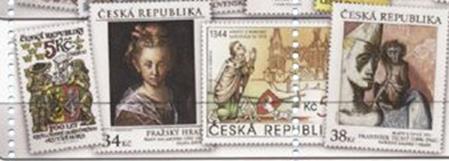
|
|
|
|
|
|
Czech Rep. #3112P |
Czech Rep. #3642O |
Czech Rep. #3615O |
Czech Rep. #3692O |
Thanks to Lou Guadagno
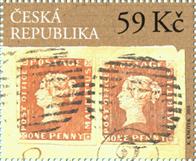
Scott: #????O
Issued: 08.08.2018
The Bombay Cover
 Inside #????: Mauritius #1 (1 penny stamps with unique wide margins)
Inside #????: Mauritius #1 (1 penny stamps with unique wide margins)
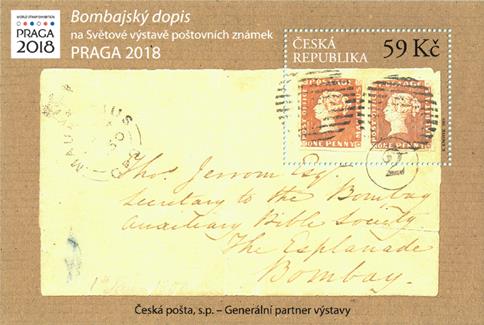
Scott: #????O
the legendary Bombay Cover, one of the three most expensive
philatelic products. It is a letter addressed to Thomas Jerrome, Esq.,
Secretary to the Bombay Auxiliary Bible Society. The sender remained unknown
until 1976 when the then owners of the letter consented to its opening. He was
the Reverend Langrische Banks, who was working in
Mauritius for the British and Foreign Bible Society. The letter was sent from Port
Louis to Bombay on 4 January 1850. Since then, it had been owned by a
number of collectors until it became the property of a Czech collector on
1 December 2016. The letter is famous for its two rare 1-penny stamps with
unique wide margins.
Sold in auction for 2'400'000 EUR in 2016
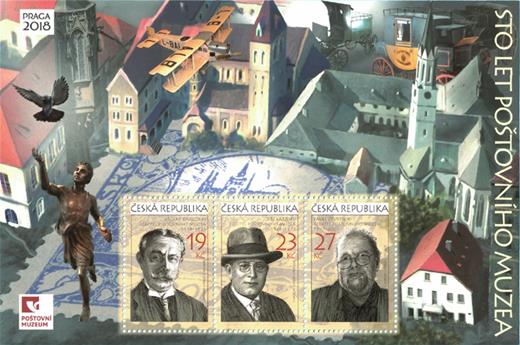
Scott: #????O
Issued: 08.08.2018
Czech Postal Museum
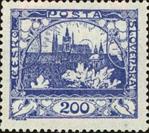 Inside #????:
Czechoslovakia #20P
(in background of 3 stamps and s/s margin)
Inside #????:
Czechoslovakia #20P
(in background of 3 stamps and s/s margin)
This issue is part of the Czech first stamp centenary celebration, yet
they have reproduced a stamp of 1919 instead of 1918.
Thanks to Lou Guadagno
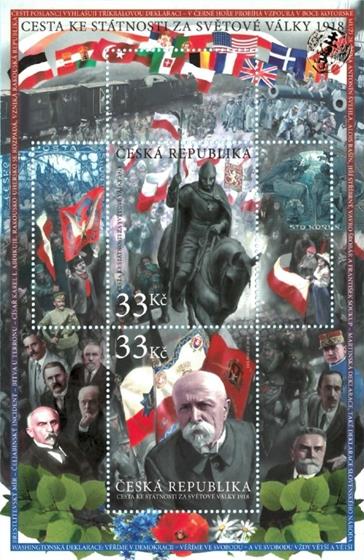
Scott: #????P
Issued: 10.10.2018
Fight for Czech Statehood 1918
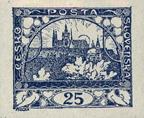 Inside #???? (in
margin): Czechoslovakia #5P
Inside #???? (in
margin): Czechoslovakia #5P
Thanks to Lou Guadagno
![[Stamp on Stamp, type AOP]](Czech%20Republic_image275.jpg)
![[Stamp on Stamp, type AOQ]](Czech%20Republic_image277.jpg)
Scott: #????O,
#????P
Issued: 23.09.2020
Stamp on Stamps
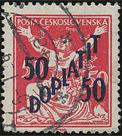 Inside #????:
Czechoslovakia #J52aO
Inside #????:
Czechoslovakia #J52aO
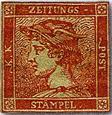 Inside
#????: Austria #P4O
Inside
#????: Austria #P4O
Red
Mercury - Austria's newspaper stamps first appeared in 1851. They depicted a
profile of Mercury, the Roman messenger god, and were not denominated, the
color of the stamp indicating the value. Blue indicated the 6/10 kreuzer rate for one newspaper, yellow for ten
newspapers (6 kr), and rose for 50 newspapers (30 kr). The higher denominations franked wrappers of bundles
of newspapers and were frequently discarded.
In
1856 a red, or scarlet, stamp with the Mercury design, sold for six kreuzer - 30 centesimi to frank a
bundle of 10 newspapers, was issued. However, it was soon superseded by a new
design depicting Franz Joseph which came out in 1858, and only a few
copies have survived.
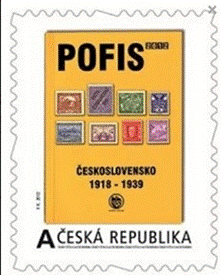
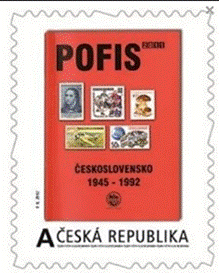
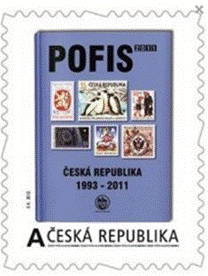
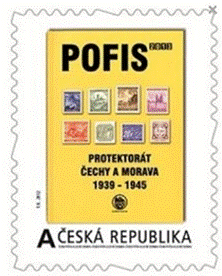
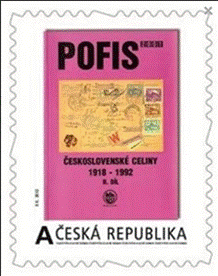
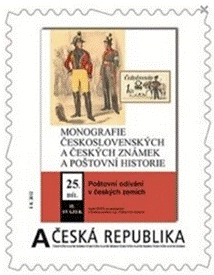
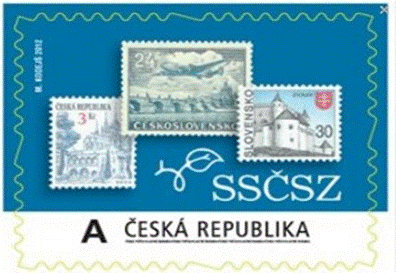
******************************
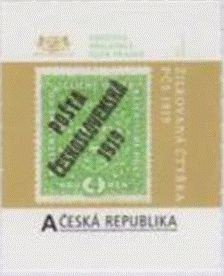
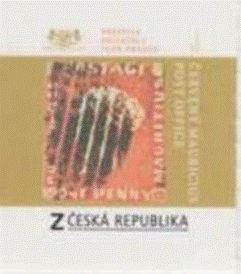
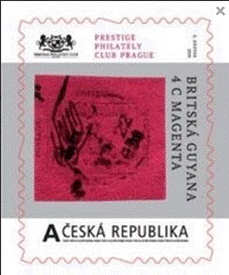
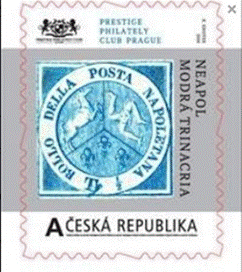
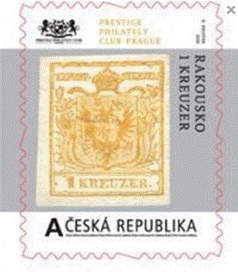
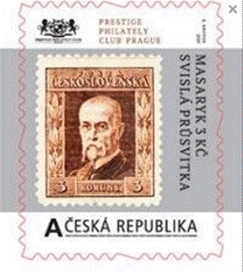
******************************
SOS personalized
Thanks
to Komlóssy Zoltán
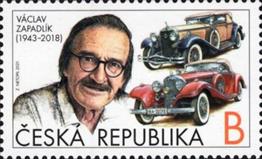
Scott: #????P
Issued: 20.01.2021
Traditions of Czech Stamp Designs
![[Classic Cars - Self Adhesive Stamps, type AAZ]](Czech%20Republic_image310.jpg) Inside #????:
Inside #????:
![[Classic Cars - Self Adhesive Stamps, type ABC]](Czech%20Republic_image311.jpg) Inside #????:
Inside #????:
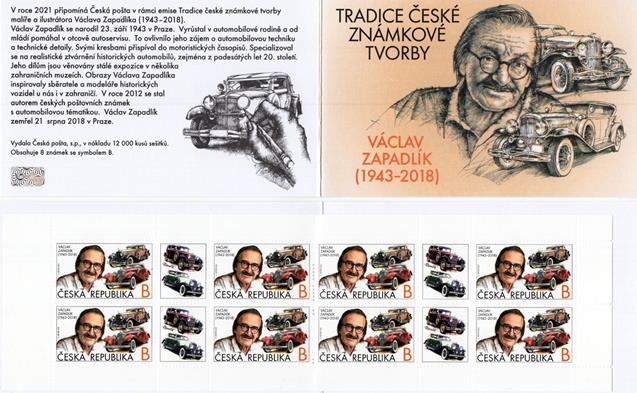
Lou Wrote: The Czech Republic issued a stamp and booklet
on January 20, 2021, a part of its continuing series on Traditions of Czech
Stamp Designs, to honor stamp designer and artist, Vaclav Zapadlik.
He is internationally known for his artwork featuring
classic automobiles, which also have appeared on Czech stamps. Reproduced
on this issue are two examples of his stamp designs, Sc #s 3545c, 3545f, released in a booklet on September 5, 2012.
Instead of full reproductions, the new issue has
what I call SOS Design Components, as only the central motifs are
shown without inscriptions and perf'ed margins. In my
records, the Design Components replace many
of the Type B designations in the old databases (a title I never liked).
Thanks to Lou Guadagno
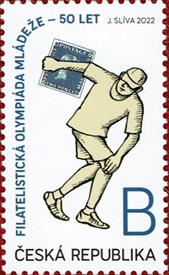
Scott: #????P
Issued: 28.05.2022
The 50th Anniversary of the Philatelic Youth Olympiad
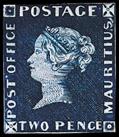 Inside #????:
Mauritius #2O
Inside #????:
Mauritius #2O
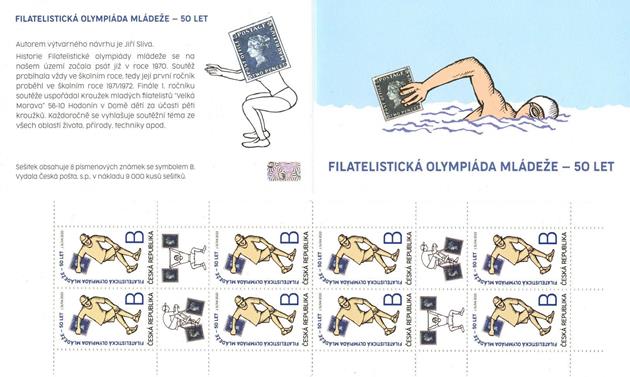
Booklet
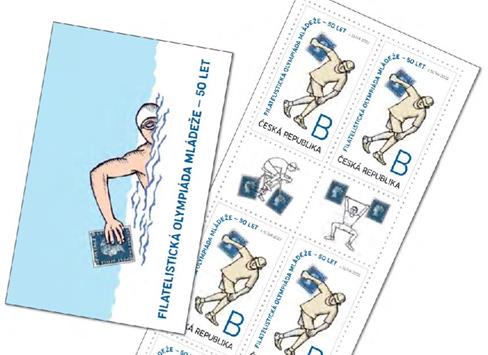
Booklet
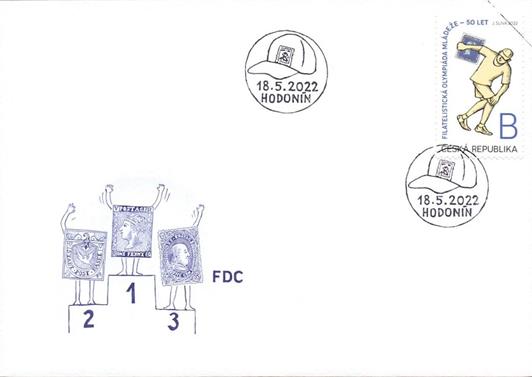
FCD
Lou Wrote: On May 18, 2022, the Czech Republic
issued a stamp in a pane of 50 and a booklet of 8
v + tabs to note the 50th Anniversary of the Philatelic Youth Olympiad. The
design shows a clever use of a Mauritius #2 as a discus for a
youthful athlete; on the booklet stamp tabs, Mauritius #2s are the
"wheels" on a bicycle and barbells for a weightlifter. On the front
and back of the booklet cover, they are again shown
with a swimmer and gymnast. The fdc cachet portrays
stylized but identifiable classic stamps as winners on an Olympic podium.
Something a little different.
|
|
|
|
|
Switzerland
#3L1 |
G.B. #1 |
U.S. #63 |
Martin Hirschbüh Wrote:
The boy is in the classical "Disco bolus" pose, the reconstructions
of which can be seen in the Museo
Nazionale Romano in Rome or at the British
Museum in London. The original was created by the
well-known sculptor Myron (around 450 B.C.) but is estimated to be lost.
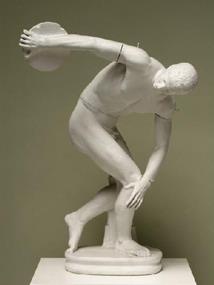
Thanks to Lou Guadagno
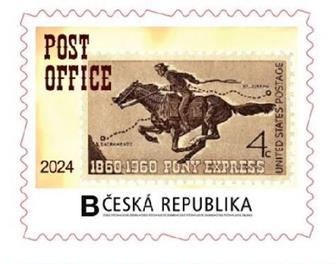
Personalized stamp (Pofis #
CES2022VZ1428)
Post Office
Issued: 01.09.2022
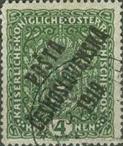 Inside: Czechoslovakia #???
(1919)
Inside: Czechoslovakia #???
(1919)
Thanks to Zoltán
Komlóssy
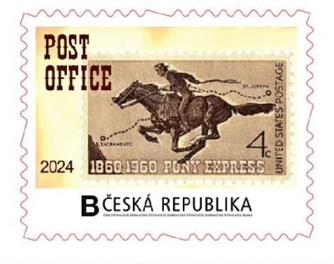
Personalized stamp (Pofis
#VZ1816)
Post Office
Issued: 16.01.2024
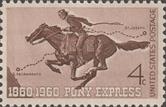 Inside: U.S. #1154
Inside: U.S. #1154
Thanks to Zoltán
Komlóssy, Richelmi
Plinio and Lou Guadagno
Best website related:
POSTFILA
A specialized section of one
of the branch works of the Czech Post - Delivery and Commercial Services.
http://archiv.radio.cz/postfila/znamky_e.html
![]()
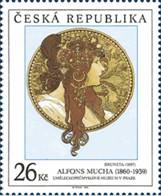
Czech Republic #3135 for St. Tomas and Prince

Czech Rep #3175d for Liberia

Czech Republic #3391 for Malawi

Czeck Rep. #3632a for Sierra Leone

![Location of Czech Republic (dark green)– on the European continent (green & dark grey)– in the European Union (green) — [Legend]](Czech%20Republic_image004.gif)
